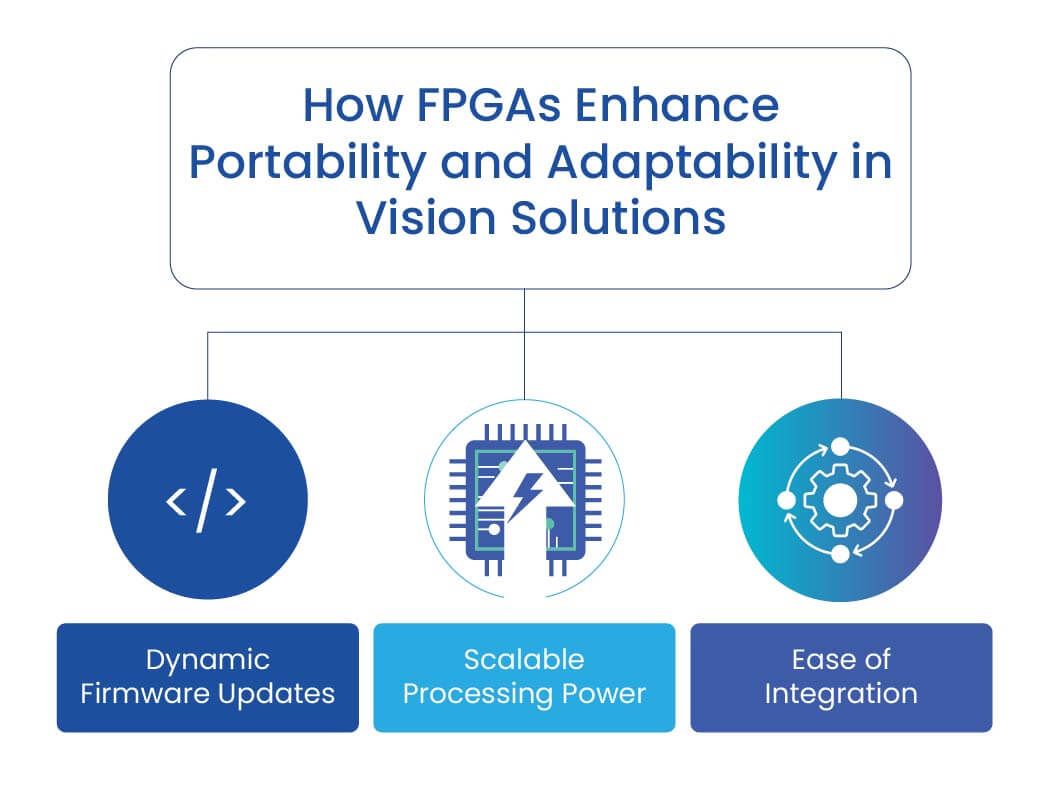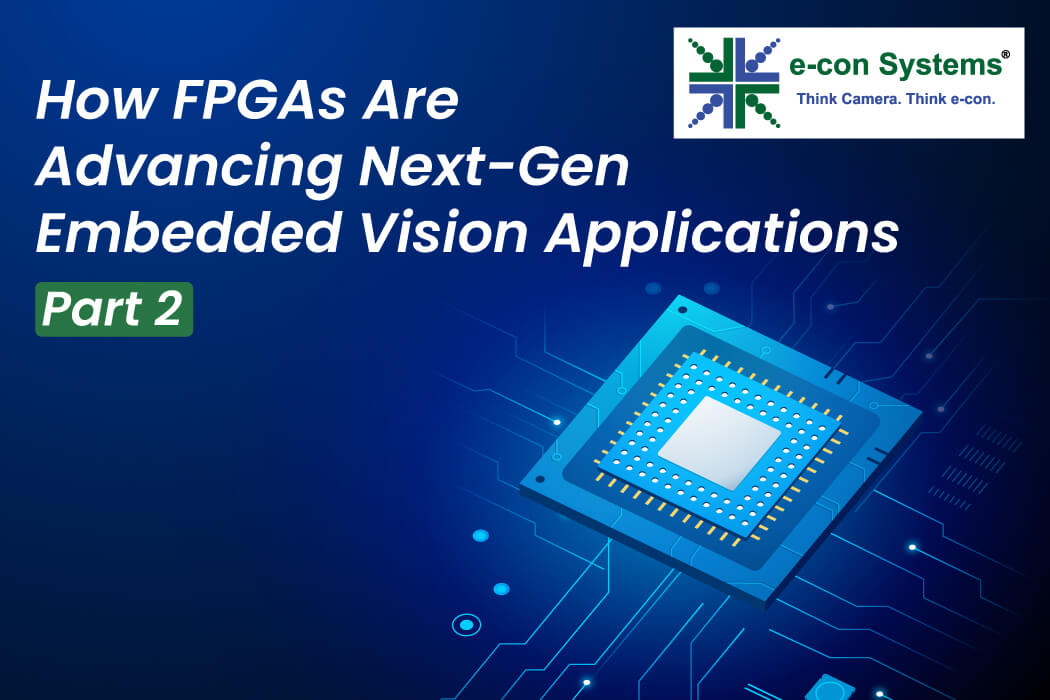Embedded vision is a huge component of modern applications, driving smart functionalities across various industries like retail, manufacturing, medical, sports broadcasting, and more. These systems are designed to handle complex tasks, process large amounts of visual data in real time, and function within strict power limitations, especially when deployed at the edge.
Field-Programmable Gate Arrays (FPGAs) are a standout choice among hardware options. Thanks to their parallel processing strengths and adaptable architectures, they help meet these complex requirements.
In part one of this blog series, you learned about the rise of FPGAs and how they make interface ports more future-ready in embedded vision applications. In part two, you’ll find out why FPGAs are uniquely suited for next-gen embedded vision systems by bringing a powerful blend of computing power, flexibility, and energy awareness, as well as their future impact.
Why Next-Gen Vision Systems Demand FPGAs
With the world increasingly moving to edge computing, vision systems demand platforms capable of running complex algorithms and handling data streams in real time. Traditional processors like CPUs often fall short in addressing performance and latency needs because they process tasks sequentially. FPGAs, on the other hand, excel by enabling parallel task execution, delivering a substantial boost in performance.
Moreover, the ability to reconfigure FPGAs even after deployment provides them with an advantage in addressing the dynamic requirements of vision workloads. Unlike fixed-function hardware, FPGAs remain agile to changes in algorithms and data models, ensuring long-term usability.
Solving Major Vision Challenges with FPGAs
Embedded vision applications face three primary challenges: computational intensity, latency, and power consumption. Here’s how FPGAs address them:
High computational demands
Vision-based algorithms like object detection and image classification require a lot of computational power to process high-resolution images and videos. CPUs, which rely on sequential execution, can’t handle these tasks properly. FPGAs overcome this limitation with their parallel processing capabilities, executing image processing tasks quickly and without bottlenecks.
Latency reduction
Low latency is crucial for vision systems operating in time-sensitive environments. While CPUs rely on software-driven execution that adds cycles to the processing chain, FPGAs leverage hardware-level processing to execute tasks directly. It significantly decreases the number of clock cycles needed for operations such as convolution, driving real-time performance for vision algorithms.
Energy optimization
Many edge devices, including cameras and sensors, are powered by batteries, which places a strong emphasis on keeping energy consumption low. GPUs, while offering substantial processing power, often require significant amounts of energy, which can severely limit their application in edge environments. FPGAs, however, provide high computational performance with much lower energy demands.
For example, certain FPGAs are designed to consume less than 70 microamps when in standby mode. It makes them great for scenarios where power usage must be carefully managed, such as in applications that must operate for longer periods on limited energy resources.
How FPGAs Enhance Portability and Adaptability in Vision Solutions
The success of new-age embedded vision systems depends heavily on their ability to adapt and perform in different environments without needing major hardware changes. FPGAs excel in this regard, offering a reconfigurable architecture that supports high-performance computing at the edge.

Dynamic firmware updates
FPGAs offer the ability to update firmware on demand, enabling features like support for 14-bit image processing. It eliminates the need for physical modifications to hardware and ensures seamless compatibility with advanced vision algorithms.
Scalable processing power
As discussed earlier, FPGAs provide the processing power necessary to handle intensive tasks with reduced latency. Their parallel architecture allows vision solutions to scale, whether processing 2D or advanced 3D imaging.
Ease of integration
FPGAs make it easier to integrate with different hardware components. For instance, you can replace or upgrade the host platform without interfering with the image sensor configuration. This reduces downtime during system upgrades and helps maintain consistent performance, even as setups grow and evolve.
Delivering Rapid and Dependable Responses with FPGAs
In embedded vision systems, real-time responsiveness is crucial. Delays in processing can lead to operational bottlenecks or failures in time-sensitive applications such as medical imaging, autonomous vehicles, or industrial automation.
FPGAs are well-equipped to handle the high data rates related to contemporary vision systems. They process input streams from numerous sensors together, resulting in uninterrupted performance even in data-heavy applications.
Furthermore, when fast and reliable responses are needed, FPGAs outperform other hardware solutions. Their hardware-level execution lowers processing delays, driving real-time decisions that are necessary for applications like robotics and traffic monitoring.
Future of FPGAs in Modern Vision Applications
The evolution of FPGA-based embedded systems is set to unlock new possibilities for modern vision systems. Their ability to adapt and scale ensures they are relevant as hardware and software requirements continue to expand.
Future innovations in FPGA design are expected to deliver even greater computing power at the edge. Such improvements will allow systems to handle more sophisticated image analysis tasks, such as identifying minute details in high-resolution or multi-spectral images.
As camera resolutions increase, sensors begin capturing data across broader spectral windows, and applications demand features like 3D imaging, FPGAs will remain important in enabling these advancements. They will also support higher interface data transmission rates, meeting the needs of next-generation vision systems.
Finally, the flexibility of FPGAs ensures their continued adoption across industries. From healthcare to industrial automation, these systems will power the development of innovative solutions that leverage the latest in vision technology.
Unlock the Potential of FPGAs with e-con Systems
Since 2003, e-con Systems has been designing, developing, and manufacturing OEM camera solutions. In collaboration with vendors like Lattice, Efinix, and Xilinx, we streamline the creation of FPGA-powered camera solutions for industry-specific applications, including medical, ADAS, industrial automation, and more.
Our featured cameras include See3CAM_CU83 (4K AR0830 RGB-IR USB 3.2 Gen 1 camera), DepthVista_USB_RGBIRD (3D ToF USB camera), and See3CAM_CU135M (4K monochrome USB 3.1 Gen 1 camera).
Our camera solutions are built using advanced FPGA chips from our vendors, ensuring top-tier performance for embedded vision applications.
Additionally, e-con Systems offers full support, including custom design services, reference designs, demo software tools, IP cores, and hardware platforms to accelerate your development process.
Explore our Camera Selector to view our end-to-end product portfolio.
If you’re looking to integrate custom cameras into your embedded vision applications, please write to camerasolutions@e-consystems.com.

Prabu is the Chief Technology Officer and Head of Camera Products at e-con Systems, and comes with a rich experience of more than 15 years in the embedded vision space. He brings to the table a deep knowledge in USB cameras, embedded vision cameras, vision algorithms and FPGAs. He has built 50+ camera solutions spanning various domains such as medical, industrial, agriculture, retail, biometrics, and more. He also comes with expertise in device driver development and BSP development. Currently, Prabu’s focus is to build smart camera solutions that power new age AI based applications.




